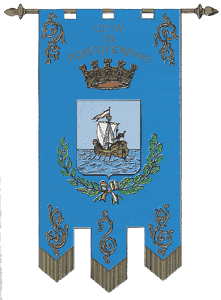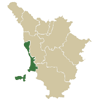|  Inhabitants in 1991: 11.042 Inhabitants in 1991: 11.042
 It
is the capital of Elba; its territory extends for 47,78 square
kilometres on a promontory and along the gulf of the same name, and comprises
also the Island of Montecristo. Historic capital it was named city
by Ferdinando II in 1637. It
is the capital of Elba; its territory extends for 47,78 square
kilometres on a promontory and along the gulf of the same name, and comprises
also the Island of Montecristo. Historic capital it was named city
by Ferdinando II in 1637.
Of Roman origin with the name of Fabricia, destroyed by the
Saracens and revived in VIII century as Feraria, from the year
one thousand, it belonged to Pisa until 1399 when it constituted (with
the rest of Elba, Pianosa, Montecristo and the Piombinese territory) the
Lordship of the Appiani. The basis of the further development of Portoferraio,
whose harbour and defensive vocation is written in its extraordinary orographic
and morphologic character, was the surrender sanctioned by Emperor
Carlo V in 1548, to Cosimo I de’Medici. This gave immediate
rise to extensive fortification works there and Cosimo then re-baptised
it with the name of Cosmopoli; other works were undertaken by Ferdinando
II and subsequently by Cosimo III. During the course of the XVIII century
the square of Portoferraio played an important role in the strategies
and treaties of the great European powers. After the brief interlude
of the English domination (1796-1799) it passed to the French State; but
the period of greatest celebrity was from May 1814 to February 1815 when
it was the residence of Napoleon and capital of the little Sovereign
State of Elba. It then became in 1815 a part of the Grand Duchy.
During the Fascism it was the centre of strong opposition to the
regime, particularly among the steel workers; and during the German occupation
it contributed to the liberation war with the activity of an autonomous
partisan nucleus.
Places to visit:
Palazzo Comunale, known also
with the name of Biscotteria, because of the bread ovens therein.
It was built in 1562 and visibly remodelled in the 1800s.
Palazzina
dei Mulini and Villa San Martino, elegant constructions adapted
for Napoleon’s stay, forming the National Museum of the Napoleonic
Residence.
Bastioni Medicei, imposing defensive barrier
constructed by Buontalenti in 1558.
Forte Stella, stately
1400s construction, now occupied as a private house.
Civil
Museum of Archaeology, hosts a collection of underwater and island
finds, datable from VIII century B.C. to the late Imperial era.
Cathedral, XVI century construction, it was enlarged in the
successive centuries. It is entitled for the Nativita of Maria.
Church of the Misericordia, erected in 1582 and remodelled
in 1700s, has a small museum of Napoleonic relics annexed to it. |
Historical info reproduced upon authorization of Regione Toscana - Dipartimento della Presidenza E Affari Legislativi e Giuridici
Translated by Ann Mountford |